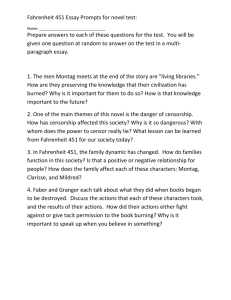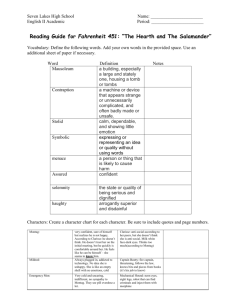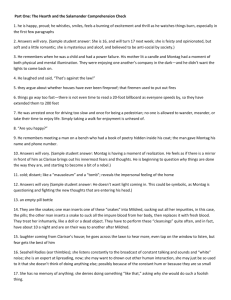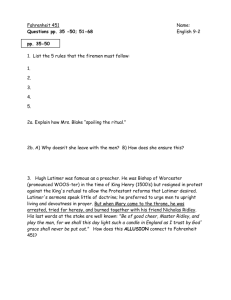Fahrenheit 451 study questions and answers - part 1
advertisement
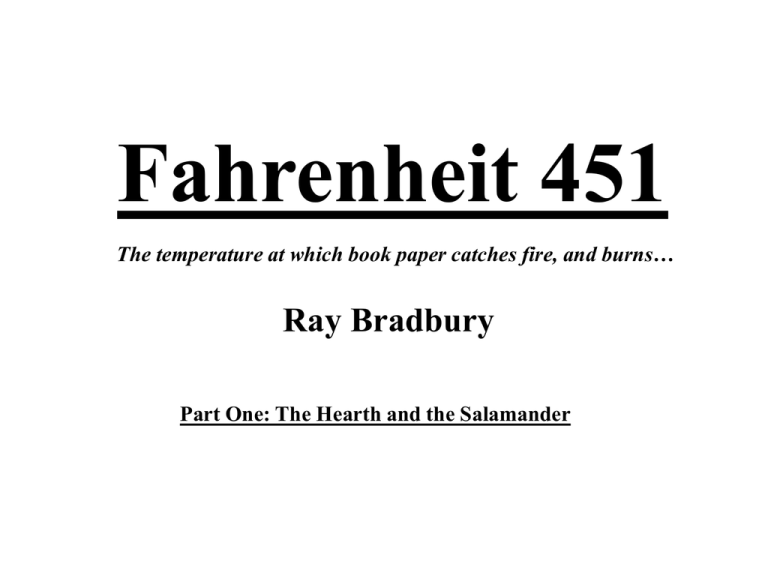
Fahrenheit 451 The temperature at which book paper catches fire, and burns… Ray Bradbury Part One: The Hearth and the Salamander Part 1: The Hearth and the Salamander 1. a) When does this story take place? The story takes place in the future, approximately 500 years from the time this book was written, so we estimate around the year 2450. The story is also set in the autumn. b) What clue does the author offer to support this theory on page 4? The author uses technology that doesn’t exist yet to support his theory. The example on page 4 would be: « the silent air-propelled train slid soundlessly down its lubricated flue in the earth and let him out with a great puff of warm air onto the cream-tiled escalator rising to the suburb. » On page 5 we know it is autumn when the author writes: “ The autumn leaves blew over…”. 2. a) What does Guy Montag do for a living? (p. 3-4) Guy Montag is a fireman. In this book, firemen start fires in houses to be able to burn the books inside of these. b) How does he feel about his job at the beginning of the novel? Find one sentence that supports your answer. (p. 3) The main character is very happy with his job in the beginning of the novel as we can see in the first two lines: “It was a pleasure to burn. It was a special pleasure to see things eaten, to see things blackened and changed.” 3. a) Find a metaphor on page 3. The metaphor found on page 3 is: “…with this great python spitting its venomous kerosene upon the world…” b) Find a metaphor on page 5. The metaphor on page 5 is: “Her face was slender and milk-white, and in it was a kind of gentle hunger that touched over everything with tireless curiosity.” 4. a) Explain the symbolism of the girl’s “milk-white” face and white dress. (p. 5) The girl’s face and dress are milk-white and this symbolises purity. She is only 17 years old and very pure. White also symbolises the girl’s frailty and femininity. It also serves as a contrast to the very dark nature of the novel. b) At what other point in the story does the author use this same technique? (p. 36-38) When the author is speaking of the book as an innocent thing: “ A book lit, almost obediently, like a white pigeon, in his hands, wings fluttering. In the dim, wavering light, a page hung open and it was like a snowy feather, the words delicately painted thereon.” Once again, the author has used the whiteness to show the oppression in this world so sombre. 5. a) Why do they have 200 foot-long billboards on the side on the highway? (p.9) The author explains this well when Clarisse asks Montag: “Have you seen the two hundred-foot-long billboards in the country beyond town? Did you know that once billboards were only twenty feet long? But cars started rushing by so quickly they had to stretch the advertising out so it would last.” b) What is Clarisse referring to when she talks about green, pink, white, and brown blurs (p. 9) When Clarisse speaks of green blurs, she is referring to grass, pink blurs to rose gardens, white blurs to houses and brown blurs to cows. This is telling us that the drivers are driving very fast and therefore do not take the time to examine what’s around them. 6. What clue does the author give in order to describe human interaction in Guy’s world? (p. 10) The author describes human interaction in Guy’s world as very superficial when he describes his apparently casual meeting with Clarisse as unusual. We know this when the author writes: “What a strange meeting on a strange night. He remembered nothing like it save one afternoon a year ago when he had met an old man in the park and they had talked…” 7. The author describes Montag’s bedroom as cold, dark, and quiet. Find two words that support this statement. (p. 11) The author describes his room as cold, dark, and quiet when he says words like: “mausoleum, tomb and darkness” The first two are resting places for the dead and the last one speaks for itself. 8. a) In your own words, summarize how Mildred was saved from certain death after overdosing on pills. (p. 14-15) Mildred was saved from certain death after overdosing on pills by a couple of machinists. The first machine pumps out the poison with a tube that went into her stomach. It had a camera at the end of it that the operator looked through. The other machine served as a blood transfusion mechanism. It replaced the contaminated blood with new one. b) What is significant about the manner in which the “Operators” saved Mildred’s life? (p. 14-15) The fact that it was a the operators saved Mildred in a very mechanical way, instead of doctors, shows us how evolved the technology has become. It is also significant in the sense that it is done in a casual manner and that it is very normal to do so in this world. c) Why do you think Mildred decided to take all of these pills? I think Mildred decided to take all of these pills because she was not satisfied with her life. She knew there was better ways to live and decided that she could never achieve this way of living because of her social status. We know there are a lot of these cases when the operator says: “We get these cases nine or ten a night. Got so many, starting a few years ago, we had the special machines built.” 9. What is the significance of Guy’s meeting with Clarisse? What effect does it have on him? Guy’s meeting with Clarisse is very significant because it opens him to the thought process. He never stopped to analyse anything before. He just did what he was supposed to do, like burn books. It has the effect that he is beginning to think things out. Example: “Of course I’m happy. What does she think? I’m not? he asked the quiet rooms.” (p. 10) and “ There are too many of us, he thought…” (p. 16). 10. On page 18, what clue does the author give to show that this story is taking place in the future? The author shows the us that this story is taking place in the future with the help of technology again when he says: “Toast popped out of the silver toaster, was seized by a spidery metal hand that drenched it with melted butter.” and “She had both ears plugged with electronic bees”. 11. Find an antithesis on page 24. The antithesis found on page 24 are: “…a hotness and a coldness, a softness and a hardness, a trembling and a not trembling…” and “slept but did not sleep, lived but did not live”. 12. a) How does Captain Beatty describe the Mechanical Hound? Find on sentence that supports your answer. Captain Beatty describes the Mechanical Hound as emotionless and it acts upon our reactions / way of thinking, on page 26, when he says: “It doesn’t like or dislike. It just ‘functions.’ It’s like a lesson in ballistics. It has a trajectory we decide on for it. It follows through. It targets itself, homes itself, and cuts off. It’s only copper wire, storage batteries, and electricity.” b) What is symbolic about the Hound? The Hound is a symbol of cruelty and bitterness. We know this when Montag describes the programming as: “all we put into it is hunting and finding and killing. What a shame if that’s all it can ever know.” (p. 27) Beatty further proves the symbolism of the type of justice in this world when he replies to Montag by saying: “It’s a fine bit of craftsmanship, a good rifle that can fetch its own target and guarantees the bull’s-eye every time”. It is also symbolic of the society because it just does and doesn’t think before doing. 13. a) How does Clarisse describe the education system in her society? (p. 29) Clarisse describes the education system in her society as her society in general, that is that you are told what to think. She describes a typical day at school: “An hour of TV class, an hour of basketball or baseball or running, another hour of transcription history or painting pictures, and more sports, but do you know, we never ask questions, or at least most don’t; they just run the answers at you, bing, bing, bing, and us sitting there for four more hours of film teacher.” b) Contrast Clarisse and the other Students her own age (p. 29-31). Clarisse is considered antisocial and doesn’t mix with the others. While the others do as they are told, they are considered social. She gives this diverging opinion on socialism when she tells Montag: “Being with people is nice. But I don’t think it’s social to get a bunch of people together and then not let them talk, do you?”. c) What is ironic about the other students’ perception of Clarisse? It is very ironic that other children don’t like Clarisse because she is afraid of them. I say this is ironic because it would be normal to be afraid of people who kill each other. “I’m afraid of children my own age. They kill each other…I’m afraid of them and they don’t like me because I’m afraid.” 14. a) How does the author exemplify society’s indifference or lack of caring and understanding on page 32? The author exemplifies society’s indifference when the firemen are playing cards nonchalantly while a war is going on outside. “ November fourth…sighing on their cards…The voice clock mourned out the cold hour of a cold morning of a still colder year…war may be declared any hour…” b) Find another example of this on page 44. Another example of society’s lack of caring would be when the author writes: “ And he remembered thinking then that if she died, he was certain he wouldn’t cry. For it would be the dying of an unknown, a street face , a newspaper image…” 15. What do we learn about Guy and Mildred’s relationship on pages 43 and 44? We learn that the Montags don’t really know each other when they can’t remember when they met: ““Why it was at-” She stopped. “I don’t know,” she said. He was cold. “Can’t you remember?” “It’s been so long.” “Only ten years, that’s all, only ten!” The author also mentions the wall between the two: “…wasn’t there a wall between him and Mildred…” 16. a) What do we learn about Clarisse on page 47 We learn that Clarisse is dead on page 47 when Mildred tells Montag: “I think she’s gone…I think she’s dead…no the same girl. McClellan.” b) Analyze Mildred’s speech. How does the way she talks reflect her personality? Mildred’s speech shows us that she is impersonal when she forgets about the neighbour being killed by a car four days ago. She also isn’t sure of the situation and doesn’t seem to care to much when she says: “No, not sure. Pretty sure…Forgot…I forgot all about it”. 17. a) What is the cause of Montag’s “illness”? Montag’s illness is caused by the fact that a woman has died in a fire that they caused the night before. “We burnt a thousand books. We burnt a woman….she was rational as you and I, more so perhaps, and we burnt her.” (p. 50-51). b) Do you believe he is actually sick? Explain. I don’t believe he is actually sick because he is questioning his career and has a book he wants to read. “Montag fell back in bed. He reached under his pillow. The hidden book was still there. Mildred, how would it be if, well, maybe, I quit my job awhile?” (p. 50-51). 18. On page 51, what reason does Montag give for becoming a fireman? Montag tells us that he didn’t have a choice of career. He had to follow his family line of work when he says: ““Thought!” he said. “Was I given a choice? My grandfather and father were firemen. In my sleep, I ran after them.” on page 51. 19. How does captain Beatty justify the burning of books? What reasons does he give to support his theory? (p. 58-63) Captain Beatty justifies the burning of books as a means to eliminate prejudice against intellectualism and thus improve happiness. We see this when he says: “the word ‘intellectual’, of course, became the swear word it deserved to be.” (p. 58) and “You must understand that our civilization is so vast that we can’t have our minorities upset and stirred…People want to be happy, isn’t that right?” (p. 59). He also says that this happiness is the backbone to his theory when he speaks of death on page 60: “Five minutes after a person is dead he’s on his way to the Big Flue, the Incinerators serviced by helicopters all over the country. Ten minutes after death a man’s a speck of black dust. Let’s not quibble over individuals with memoriums. Forget them. Burn all, burn everything. Fire is bright and fire is clean.” 20. As Montag looked through a window, he remembered that Clarisse had once mentioned that most houses had no front porches, no gardens, and no rocking chairs. Why do you think this is so? Most houses don’t have any front porches, gardens or rocking chairs because this led to discussion and analyzation of the day passing by. It is considered as dead time, time to think. “…the real reason, hidden underneath, might be they didn’t want people sitting like that, doing nothing , rocking, talking; that was the wrong kind of social life. People talked too much. And they had time to think. So they ran off with the porches. And the gardens, too.” (p. 63).
